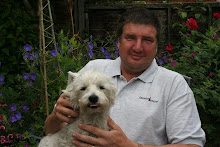 |
| Another chunk of jungle bashed into submission. |
I apologise in advance for a bit of a thin report this time. The weather has finally turned nice enough to get out into the garden and life since the last post has been all about weeding. Unless you want a piece entitled "My Battle with Creeping Buttercup, Silverweed, Couch Grass, Docks, Daisies and Plantains", I will struggle to put any drama into the words. The weeding was long overdue but I hate getting the knee pads on and squelching around with the wet threatening to come over the sides of the pads and soak my knees. I have done hours and hours of just plain hand-weeding, bits of several days from around 08:45 to 11:45. The compost piles are mountainous.
 |
| A buddleia in a not very sensible position. |
The good weather also attracted Liz out, and, 2-handed, we have been able to get on with some projects. The first of these was to do battle with what we thought was our last piece of 'jungle'. These little corners of rubbish seem to occur in all our gardens - you mean to tackle them but you've no time right now, so I'll stack this 'stuff' in it for the present; of course, you end up with mini 'glory-holes' of stacked canes, sheets of plastic and other junk with brambles and nettles trying to grow through them and all your locals weeds running rampant.
 |
| The patch now clear but re-sheeted to hold it. |
Ours was a ten foot wide, 20 foot long gap between the polytunnel and the raised flower bed. When we bought the place this hole was, like several other bits, full of well rotted bales of hay and straw and the 'earth' was a mess of half-buried silage wrap, rocks and old peat-turf, overgrown with a jungle of nettles, brambles and long, lank, wet grass. In the short term, we decided to just sheet it over with black plastic and use that dry, black surface to dry out the chunks of turf I was pulling out of the earth bank at the time (I still am!). Most of this turf got dried and has been burned, but the smaller fragments sat on the plastic through a couple of winters and, as you'd expect, started to grow their own ecosystem of grass and weeds.
 |
The roses are now fighting back after the wet and producing
buds which actually manage to open (!) |
The sheeting I had put down did not come right to the edges, so the biggest rat's nest of nettles grew there, I have ever seen - stems were 5-6 feet high and the roots, once finally extracted were more than an inch thick at the centre of the clump. On the outer edge of the gap was the chicken wire we had put surrounding the flower bed to keep the birds off and (again no surprise) the bottom of this had become a tangle of new weeds. We now have the bed better established and 'peopled' with sturdy perennials which can cope with chickens rooting around under and between them, so we decided to do away with the wire mesh in the same project.

A couple of days of fun, then, with fencing pliers, hammer, shears, pick axe (to break open the rotted bales and get the nettle roots out), pointy shovel, rake, stone-buckets, builders one-tonne bulk bag for the weeds and a barrow for the use-able turf. It is now cleared of nasties, dug over, stone-picked and turf-picked, raked smooth and now re-sheeted with better, flatter (and big enough) black sheeting to await the Autumn and its annexing by the existing raised flower bed. Yes, we have more plans.
 |
One of last year's 'Million Trees' oaks is
now getting cracking. |
The big bed is now down a couple of years and the plants in it have started to show their true, Roscommon potential. By that, I mean that some of them are surprising us by being bigger, taller and wider than we have ever seen them grow in, for example, Kent. We have only ever had limited success and poor growth before with such as Philadelphus (Mock Orange) and Crocosmia (Lucifer). Here, these plants are huge - the orange has 5 foot long whips coming out in all directions. A Buddleia we squeezed in at an edge (unwise) us now trying to vault across the grass path. Crocosmia is shouting 'HOT RED' in great 4-5' tall fans, one of which is near the front of the bed and hiding all sorts of goodies behind it. The lupins and sweet rocket have now gone over but stand as tall spikes of seed heads which we hate to tidy up but probably need it.
 |
| Some rose prunings make it indoors. |
We took all this in while working there and decided that we need to do some moves and shuffling as well as some evictions. The big Buddleia and Philadelphus will be headed to the woodland edge once they go quiet in Autumn. The 'Lucifers' will need lifting and dividing but we will also take the opportunity to move them back a bit, almost certainly into the cleared jungle patch. Some shorter plants may be moved forward. We do not want a rigid gradation by height; we like tall see-through stuff like purple verbena, teasel and Japanese anenome to be scattered about but the beds does need a bit of a sort out. We are currently looking at a way of mapping it all so that when we go to dig things up in October, we can tell our crocosmia from our gladioli and we can distinguish between various 'dead' brown clumps.
 |
Left to right, the 5 week old turkeys, one of the 9 week old turkeys,
a young Guinea Fowl and the olde Marans hen. |
Meanwhile, the newest hatch of turkeys have reached 5 weeks and looked big enough, to us, to cope with Soldier the cat, so we have let them out free range. We were delighted to see that the 'Gang of Four', our 2 other turkey poults and the young Guineas straight away adopted them into their gang, rather like older siblings who are asked by their parent to 'mind' the babies. There was no pecking order stuff and no harrassment. The 2 newbies were quickly absorbed and the youngsters all now travel around as a gang of six. For a couple of nights we rounded the new ones up back to their rabbit run in the evening and shut them in, but on the third evening all six went off to roost in the turkey house and looked so cosy together that I let them be and shut them all in together. Everybody survived and now I can tidy up the rabbit runs and stash them back away somewhere dry. Our 2015 breeding season is over. The remaining adolescents just need to grow up in the flock. Only 'Hen with Two' remains in any kind of kindergarten arrangement, with Mum still looking after the 5 week old babies and taking them off to the camping-toilet gap in the Tígín each night. She will soon move into the proper house, we expect.
 |
| Male turkey poult (?) at 9 weeks. |
The older turkey poults, now 9 weeks, are both looking, to our inexpert eyes, like males (Toms). They have the start of the flap of loose skin at their throats (the wattle) and we have seen both of them doing lttle play versions of Dad's display - tails up and wings down. This does not matter of course - these are still purely meat birds but possibly the males grow faster than the hens. Que Sera.











No comments:
Post a Comment